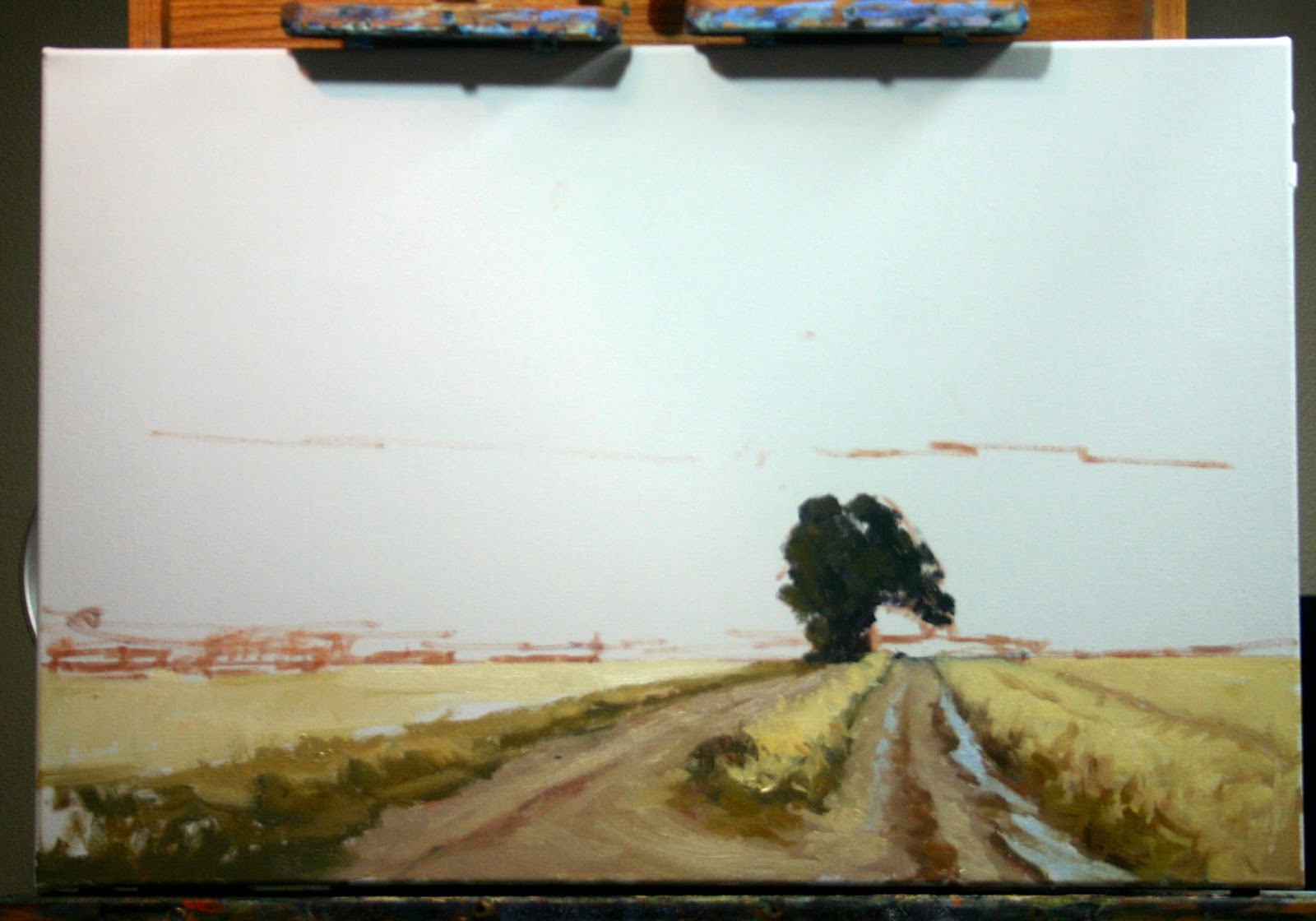I'll warn you up front that I rarely copy photos. I use them as jump off points for me to express myself creatively and to push my imagination and memory. In this case I have painted plenty of times in West Texas looking out over fields of cut hay.
Its not unusual in the heat of summer for a heavy rainstorm to form, pass through dumping loads of rain and an hour later be gone. We get summer squalls where the sky turns very dark and you'll see a heavy shower off in the distance. Then one will drop behind you, then out off to your right side and then another one way off in the distance. Its like the sky is springing leaks everywhere. I've painted in these conditions and not gotten a drop of rain on me. I've also had the opposite happen where the sky just dumps its entire load on your head.
So any way, I'll probably stick to an accurate rendering of the ground plane, but the sky will most likely come out of my head.
A quick sketch of the ground plane. In the photo the tree is fairly close to the middle which would be a disaster in a painting so I have moved it over to the right a bit. This changes the angle of the road and because the road is a little too straight in the photo I add a curve to it. I'm already thinking the tree is too tall but I'll wait a bit to make any final decisions about it.
I paint the ground plane almost to completion. I've added some water sitting in the rut of the road on the right side just to see how that effect feels and I kind of like it.
This is why painting outdoors and memory comes into play when doing a studio painting. I've been outside enough to have seen the reflected light coming from the ground hitting the underbelly of clouds. I don't see it in the photo, but I definitely know its there so I go ahead and paint it. This is when the bright sun, hits the yellowish field of hay and that light bounces back up into the clouds.
I have blocked in the front row of clouds and now I step back from the painting to decide if I want to keep the rain over on the left and I do, so I'm good to paint more clouds.
Trouble in paradise...so far everything has been going along well, then for about two hours I struggle with the clouds and when things aren't going as planned I've learned to swallow my pride and wipe off the offending portion of the painting that is not cooperating. Sometimes my hands have a mind of their own and they mix colors I don't want or they hold the brush the wrong way or apply paint in places or in a fashion my mind is not wanting.
When that happens its time to take a break and force my mind and hands to have a conversation and come to some kind of agreement on how we are going to proceed. If they continue to fight with one another I just call it a day and find something else to do.
Finally after much conversation and repainting the same area about a dozen times, the clouds finally begin to take shape and I'm pleased with the result.
The trick to painting clouds is to be patient with the process and to make them look as if they are occupying large amounts of space by using overlap and paying attention to the subtle shifts in color as one cloud sits in front of another or casts a shadow onto a lower flying cloud.
The best blending tool I own is my right index finger.
That's why I always get paint on my face or clothes.
Here's a couple of close ups. This is the rain off to the left and hay bales.
Here's the road and tree.
Here are some of the clouds. You can see the reflected light from the ground on the left cloud.
And below is the finished painting.
"Passing Storms" 20" x 30" oil/canvas
Copyright 2014, Rusty Jones















7 comments:
Wonderful painting, Rusty, and thank you for the generosity of sharing your process. Such a learning experience and very interesting...
I thoroughly enjoyed reading about your progress on this painting. Artists make so many last minute choices, at least I do. I so appreciate when other artists can write about their creative process also. Thanks for posting the photos. This is a lovely painting.
Thank you Maren and Susan for leaving comments. I enjoy getting them and it reinforces my comittment to the blog. I really appreciate it.
Thank you Maren and Susan for leaving comments. I enjoy getting them and it reinforces my comittment to the blog. I really appreciate it.
I appreciate the report of your process, Rusty. Nicely done.
Randy--This is a really interesting post. I have to say that I am over in Shanghai working on a project here and also working on ideas for remodeling my house when I get back to the states in early 2016. I saw a painting I loved in a photograph in the Houzz.com website (Amarillo Grain Elevator) which I loved (and saved it specifically for that reason.) I Googled Grain Elevator paintings and thankfully, your painting came up and followed it to this site. I have to say I'm very captured by your style and very happy I found an answer to my quest. You now have a fan of your work over here in China!
nice blog Rusty, I just came across it. Enjoyed seeing your painting in progress. I know how hard to record the progress because you have to be aware of time and stop frequently to take pictures. Thanks for posting!
Post a Comment